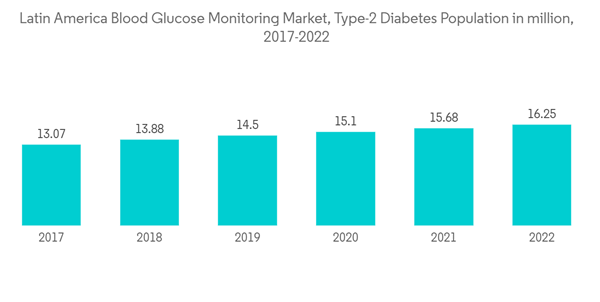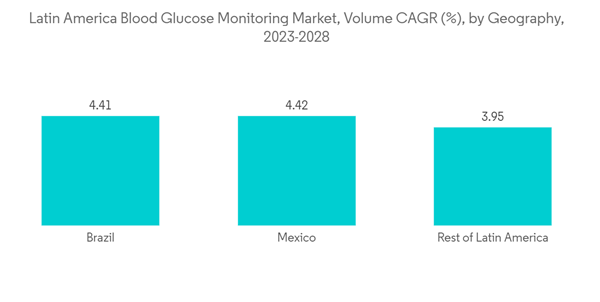The COVID-19 pandemic has substantially impacted the Latin America Blood Glucose Monitoring Market. People with diabetes have a weak immune system so, with COVID-19, the immune system gets weaker very fast. People with diabetes will have more chances to get into serious complications rather than normal people. The manufacturers of diabetes care devices have taken care during COVID-19 to deliver the diabetes care devices to diabetes patients with the help of local governments. Doctors around the world suggested diabetes patients should check their diabetes levels more often to be careful, which leads to an increase in the usage of diabetes care devices.
The COVID-19 pandemic has been testing the capacity to respond and adapt to populations, governments, and health systems worldwide. Brazil presented the first suspected and the first confirmed case in the Latin America region. Most Latin American countries failed to implement timely measures to protect individuals with diabetes, which severely impacted individuals, health systems, and economies.
The diabetic prevalence is high in countries in the Latin American region, and Mexico is known to have a high number of diabetic patients due to the growing prevalence of Type-2 diabetes in the country. The gradually growing obesity rate, combined with the genetic predisposition for Type-2 diabetes, acted as a prominent driver for the increase in the Type-2 diabetic population over the last 40 years. Currently, close to 10% of the total population is living with diabetes. Diabetic patients in the Latin American region mainly suffer from Type-2 diabetes, and they accounted for close to 90% of the total diabetic population in 2021.
Therefore, owing to the aforementioned factors the studied market is anticipated to witness growth over the analysis period.
Latin America Blood Glucose Monitoring Market Trends
Self-Monitoring Blood Glucose Devices hold the highest market share in the Latin America Blood Glucose Monitoring Market in the current year
Self-Monitoring Blood Glucose Devices hold the highest market share of more than 60.5% in the current year in the Latin America Blood Glucose Monitoring Market.Self-Monitoring Blood Glucose is an approach used by diabetic patients to measure their blood sugar level using a glucometer, test strips, and lancets. Based on the readings, patients can adjust or check the effect of their treatment. Although CGM is an advanced way for people with diabetes to check glucose readings in real-time, SMBG is the most preferred device by patients. It is due to its economic affordability and less sophisticated usage than CGM.
The growth in market volume and share of test strips are expected to be higher than that of glucose meters because of the difference in use-case frequency. The glucose meter's average efficiency ranges from 6 months to 3 years, whereas test strips are for one-time use. Introducing new kinds of lancet devices that induce lesser pain to the users is expected to help the market's growth, as the acceptance rate is expected to rise during the forecast period.
Innovative technologies, like digital health apps that display and summarize individual blood glucose measurements and incorporate additional relevant data, like insulin doses, meals/snacks, and physical activity, can further support self-management while decreasing disease burden and benefitting overall diabetes care. Integration of Blood Glucose Monitoring with insulin calculators, automated insulin titration software, and remote coaching are further developments that provide patients with poorly controlled diabetes. It needed additional support to improve critical outcomes, thereby enhancing the market prospects in future years.
Lack of health insurance deprives low-income people of access to services and puts them at risk of financial hardship. To protect the people against excessive health expenditures, many countries like Mexico implemented community-based health insurance, national health insurance, and targeted public health insurance. Mexico contains multiple health insurance providers. The Instituto de Seguridad y Servicios Sociales de los Trabajadores del Estado (State Employee's Social Security and Social Services Institute, ISSSTE) provides coverage for government employees. The Instituto Mexicano del Seguro Social (Mexican Social Security Institute, IMSS) covers private-sector employees. The Seguro Popular (People's Insurance) was launched to protect the working-age population against steep healthcare costs. Such government initiatives are expected to drive the market's growth.
Brazil is expected to dominate the Latin America Blood Glucose Monitoring Market over the forecast period
Brazil is expected to hold the highest market share in the Latin America Blood Glucose Monitoring Market and register a CAGR of about 10.6% over the forecast period.According to IDF Diabetes Atlas 2021, 15.7 million adults, about 10.5%, had diabetes in Brazil. The cost of diabetes-related health expenditure in Brazil is the third highest in the world. In addition, 18 million adults include Impaired Glucose Tolerance, which places them at high risk of developing type 2 diabetes. Additional data on glycemic control in Brazil show that only 25% met the therapeutic goal of glycated hemoglobin (HbA1c) less than 7% before the pandemic, as recommended by the Brazilian Diabetes Society.
Brazil implemented a set of reforms to improve the distribution of doctors, develop new forms of the service organization, introduce new financing models, and implement a range of quality improvement initiatives and policy frameworks to overcome risk factors such as obesity. It also highlights opportunities for continuing and expanding innovations in the delivery of diabetes care and the use of diabetes technology. In Brazil, the Brazilian health system is managed by each state and local health secretariat and is governed by the MOH. Furthermore, in many towns where the public sector cannot meet people's requirements, partnerships with private organizations are established to increase access to PHC.
According to Universal Health Coverage 2022, four nations, including Argentina, Brazil, Colombia, and Mexico, achieved an overall index of essential coverage of 76-77%, with households spending less than 25% of their income on health care. It expands access to primary healthcare systems and coverage for noncommunicable illnesses enhanced service coverage, while a rise in the number of qualified healthcare personnel enabled community outreach. In Brazil, the public health system (Sistema Único de Saúde; SUS) progressively increased the assistance available for individuals with diabetes. The Ministry of Health established a list of medications and supplies, the Brazilian Health System (SUS) provided to patients suffering from diabetes.
Such factors are expected to drive market growth over the forecast period.
Latin America Blood Glucose Monitoring Industry Overview
The Latin America Blood Glucose Monitoring Market is fragmented. Major players like Dexcom, Medtronic, and Abbott dominate the CGM devices market. The market for SMBG devices comprises key manufacturers like Roche, LifeScan, Arkray, Ascensia, etc., and other regional players.Additional Benefits:
- The market estimate (ME) sheet in Excel format
- 3 months of analyst support
This product will be delivered within 2 business days.
Table of Contents
Companies Mentioned (Partial List)
A selection of companies mentioned in this report includes, but is not limited to:
- Abbott Diabetes Care
- Roche Holding AG
- LifeScan Inc.
- Dexcom Inc.
- Medtronic PLC
- Arkray Inc.
- Ascensia Diabetes Care
- Agamatrix Inc.
- Bionime Corporation
- Acon Laboratories Inc.
- Medisana AG
- Trivida Functional Medicine
- Rossmax International Ltd.
- Senseonics










